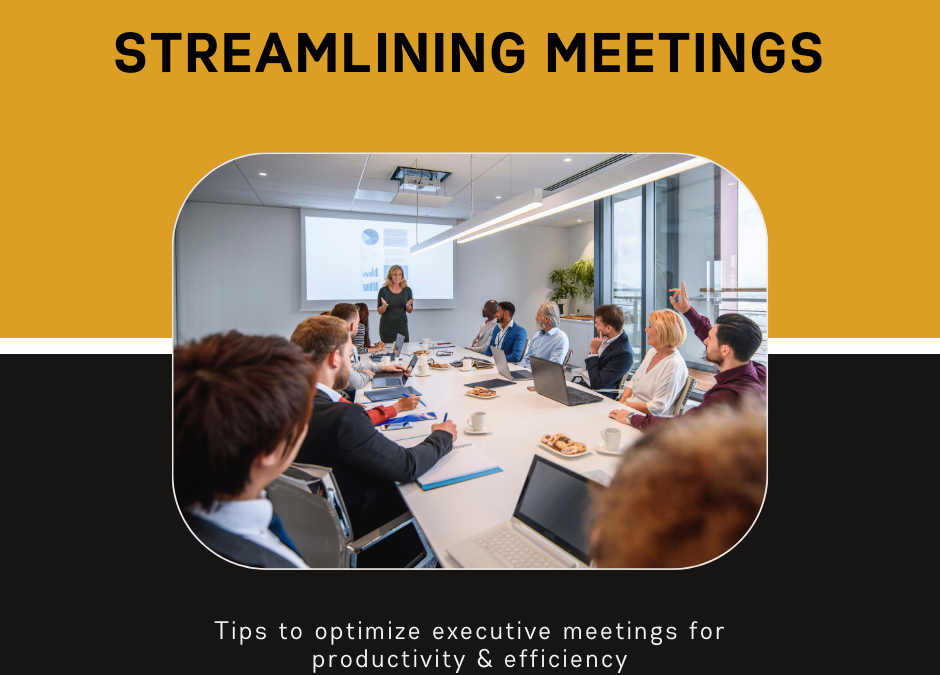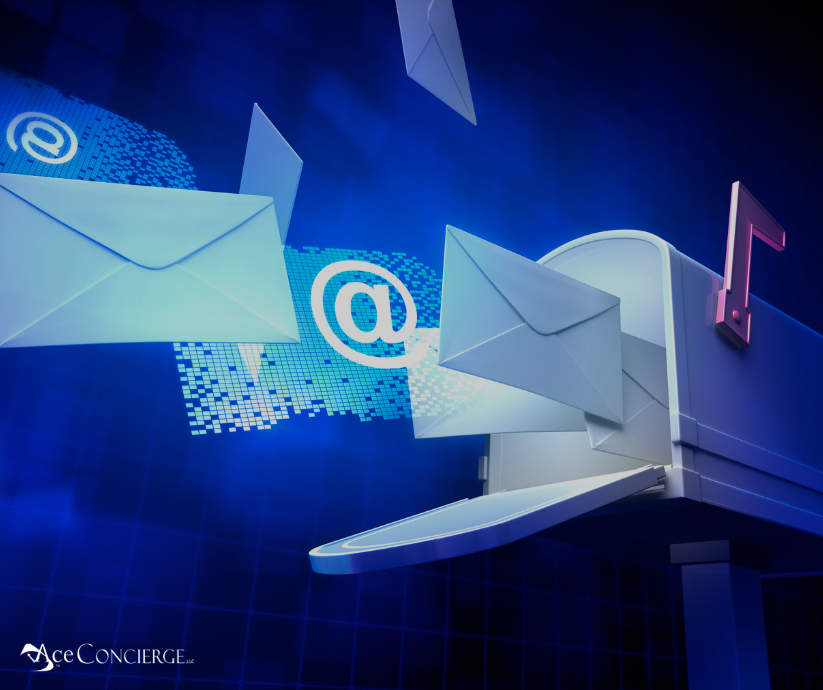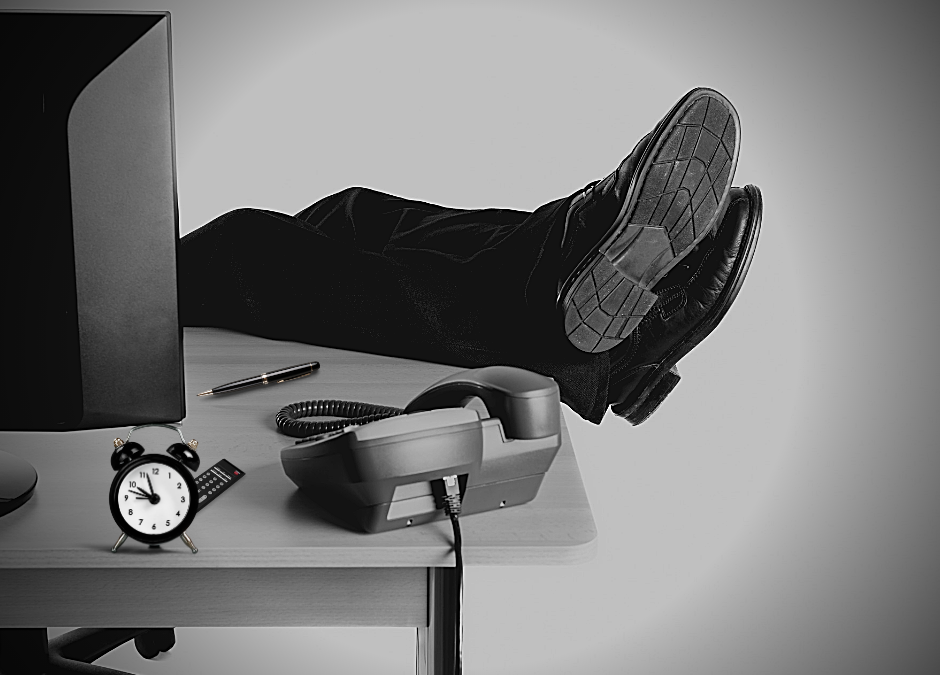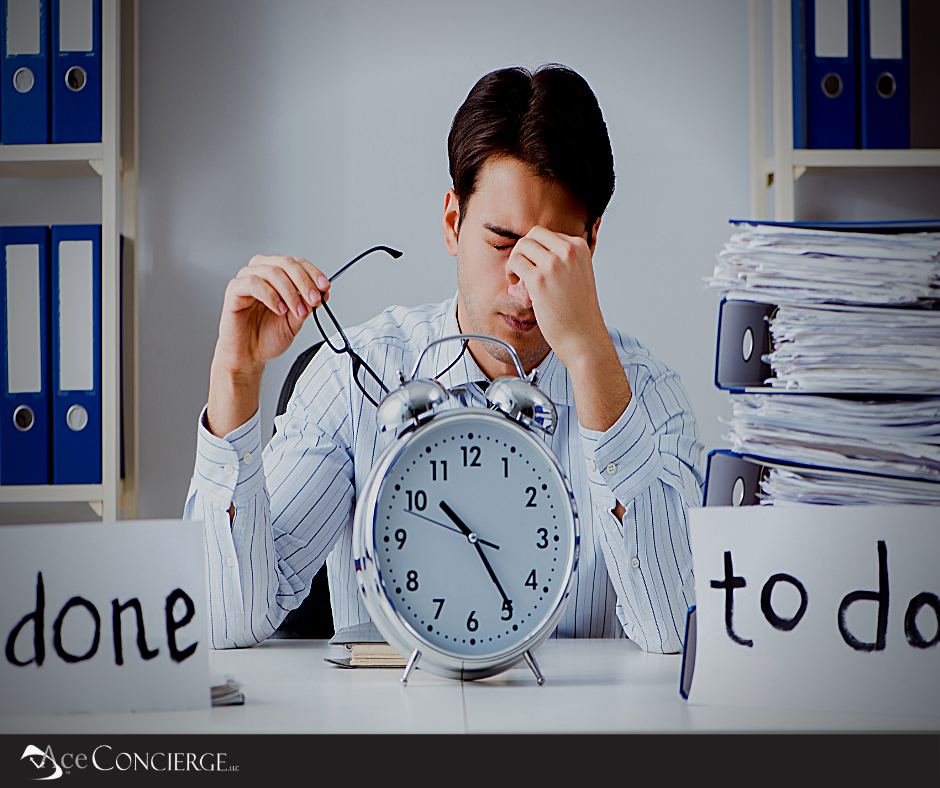
by Ace Concierge | Virtual Assistant | May 14, 2024 | Leadership, Small Business, Time Management

As a business owner or executive, you are likely familiar with the exhausting meeting marathon. It seems like every day is jam-packed with back-to-back gatherings, each promising to make progress on your most urgent priorities. However, more often than not, you come out of these meetings feeling dissatisfied, unproductive, and questioning where all the time has gone. You are not alone in this struggle. Research shows executives spend an average of nearly 23 hours weekly in meetings, with little to show. A significant 71% of senior managers view meetings as unproductive and inefficient.
So, what is the solution to streamline your meeting schedule and ensure that each gathering is a productive use of your precious time? Let’s dive in.
The Productivity Pitfalls of Inefficient Meetings
Enhancing meeting productivity requires addressing the common obstacles that impede their success. A primary concern is unclear objectives and agendas, which lead to unstructured discussions and distractions. Moreover, inadequate meeting management can result in disorganized debates and lengthy updates. The prevalence of multitasking and the overwhelming frequency of meetings also hinder productivity in the modern workplace.
Strategies for Efficient, Focused Meetings
Now that we’ve identified the common pitfalls, let’s explore some proven strategies for streamlining your meeting schedule and maximizing the productivity of each gathering.
1. Define Clear Objectives and Agendas
The old saying goes, “If you fail to plan, you plan to fail.” Before scheduling a meeting, clearly define the purpose, desired outcomes, and critical discussion points. Distribute a detailed agenda in advance so participants can come prepared and ready to contribute.
2. Designate a Facilitator
Appoint a meeting facilitator whose sole job is keeping the discussion on track, managing the time, and ensuring all attendees can voice their perspectives. This person should be empowered to politely redirect the conversation if it starts to veer off course.
3. Limit Attendees
Resist the temptation to invite everyone and their brother to your meetings. Only include the essential decision-makers and subject matter experts who need to be there. As leadership coach Cameron Herold advises, “If you have more than seven people in a meeting, you’re wasting time.”
4. Leverage Technology
Take advantage of the wealth of productivity-boosting tools at your fingertips. Virtual meeting platforms, collaboration tools, and productivity software can all boost meeting efficiency and engagement. Platforms like Zoom, Google Meet, Microsoft Teams, and Switchboard facilitate remote meetings with features like HD video, screen sharing, and real-time messaging. Project management and note-taking apps help track action items, decisions, and follow-ups. Meanwhile, virtual whiteboards and collaboration software enable more dynamic, interactive discussions.
5. Set Time Limits
Resist the urge to schedule hour-long meetings by default. Instead, aim for shorter, more focused gatherings of 30 minutes or less. If the agenda requires more time, break it into a series of back-to-back sessions with clear start and end times.
6. Follow Up Promptly
Don’t let the momentum of a productive meeting fizzle out. Immediately after the gathering, share a concise summary of key takeaways, action items, and next steps. This ensures everyone is on the same page and accountable for their responsibilities. Implementing these strategies can transform your meeting schedule from a time-sucking slog to a streamlined, high-impact part of your workday.
Maximize Meeting Productivity
Meeting optimization is a topic that can’t be overlooked without exploring the different tools and techniques that can enhance productivity. One effective method is the “stand-up” or “scrum” meeting format, where participants stand throughout the gathering. This promotes brevity, focus, and a sense of urgency. Research has shown that stand-up meetings can be up to 34% shorter than meetings where participants are seated.
Another helpful tactic is the “parking lot” technique, where topics that stray from the agenda are promptly noted and addressed separately rather than derailing the ongoing discussion.
Are you ready to revolutionize your meeting schedule from a dreaded obligation to a valuable productivity tool?

by Ace Concierge | Virtual Assistant | Jan 26, 2024 | Email Management, Leadership, Time Management

Email overload! As an executive, surviving the daily deluge of emails, it can feel like you’re dodging and weaving in a crowded marketplace.
In a MailBird 2021 study, they queried more than 250 professionals and found that:
- Nearly half of respondents (40%) receive between 61-200 emails a week. Only 10% or less of those emails are business-critical.
- A third of respondents say they spent three to five hours a week managing their inboxes. Given the low rate of business-critical emails, around 10.8 hours are wasted on average on unproductive work.
- A majority (61%) believe their personal email management methods are inadequate. Yet few believe tech solutions like email apps and email clients are the solution (20%). Interestingly, 60% of those surveyed say they don’t have the time to learn non-tech alternatives.
- Only 5% of businesses have training materials or employee manuals that go into detail on what or is not business critical communication or email management.
According to Microsoft, Workers spend 40% of their work week – two full days – on email and meetings. This generates a significant cost burden for businesses.
But fear not! Here are some battle-tested strategies to keep your inbox under control:
Prioritize Like a Pro
Don’t fall for the trap of giving equal attention to every email. Sort your emails by priority and relevance using filters and labels. Keep the most pressing matters at the top of your list and filter out the rest.
Timing is Key
Resist the itch to check your inbox every five minutes. Allocate specific time slots for email management and stick to them. This not only enhances focus but also helps you avoid getting lost in the never-ending sea of emails.
Set Boundaries for Balance
Make a conscious effort to maintain a healthy work-life balance. Set clear boundaries around your email engagement, especially outside regular work hours. Taking a break from your inbox allows you to recharge and stay sharp.
Delegate Effectively
Delegate email management tasks to a capable team member or executive virtual assistant. Communicate your expectations and empower them to handle your inbox on your behalf. This not only takes the load off you but also promotes efficiency and collaboration.
Strategies for Success: Tried and Tested
Optimize your email experience with these proven strategies
- The Power of Unsubscribe: Regularly assess your subscriptions and unsubscribe from irrelevant newsletters or updates that clutter your inbox.
- Response Efficiency: Craft concise and clear responses to expedite your communication process.
- Priority Labels: Implement a priority labeling system to swiftly identify and address critical emails.
- Batch Processing: Group similar tasks and tackle them in dedicated time blocks to enhance focus and efficiency.
- Embrace Silence: Resist the urge to respond immediately. Allow thoughtful pauses in communication to foster clarity and strategic decision-making.
With a smart approach, you can tame your unruly inbox and transform it into a productivity powerhouse for strategic thinking and effective leadership.
Isn’t it time you took back control?

by Ace Concierge | Virtual Assistant | Jan 24, 2024 | Time Management

Developing efficient executive and time management skills is an indispensable skill set for success in the professional world, regardless of your experience level. With a limited number of hours in a day and an increasing number of responsibilities, it’s easy to feel overwhelmed and struggle to accomplish everything on your to-do list.
To get you started on this journey, we’ve compiled a concise list of valuable insights and tips that you can implement today. Whether you’re a seasoned professional seeking to enhance efficiency or a newcomer to the workforce, these tips will assist you in managing your time more effectively, prioritizing tasks, and accomplishing your objectives.
1. Establish Clear Goals:
Kickstart your efforts by defining your destination. Develop SMART goals – Specific, Measurable, Achievable, Relevant, and Time-bound – providing a structured roadmap to focus your energy and guide your actions.
Friendly Tip: Think of your goals as friendly signposts on your professional journey. They guide you, keeping you on the right path with a clear sense of direction.
2. Prioritize Strategically:
With goals in sight, prioritize tasks based on importance and urgency. Employ tools like to-do lists, calendars, and schedules to maintain an organized approach, ensuring you stay on track.
Friendly Tip: Picture your to-do list as a friendly companion. It helps you navigate through tasks, ensuring you focus on what truly matters and stay ahead in your endeavors.
3. Efficient Delegation:
As an executive, learn the art of delegating tasks effectively. Distributing responsibilities strategically allows you to focus on pivotal duties, enhancing overall productivity.
Friendly Tip: Delegation is like building a supportive team. Trust your crew, empower them, and watch your ship sail smoothly through the professional seas.
4. Thoughtful Task Management:
Master the skill of discerning when to say no. Declining tasks that don’t align with your goals prevents burnout and maintains optimal performance.
Friendly Tip: Saying no is like maintaining a healthy work-life diet. It ensures you’re not overwhelmed and can savor the most meaningful tasks on your plate.
5. Optimize Time Use:
Effective time management is about maximizing your resources. Implement techniques like the Pomodoro Technique, time blocking, and the Eisenhower Matrix to make the most of your time.
Friendly Tip: Think of time management as your secret sauce. Use it wisely, sprinkle it strategically, and watch your productivity dish become a success.
6. Communicate Effectively:
In the professional setting, clear communication is key. Ensure your messages resonate by fostering an environment where everyone understands their role and responsibilities.
Friendly Tip: Communicate like you’re chatting over a cup of coffee with friends. It adds a touch of warmth and clarity to your professional interactions.
7. Elevate Leadership Qualities:
Enhance your executive standing by investing in leadership development. Attend training programs, read relevant literature, and seek feedback to refine your leadership skills.
Friendly Tip: Leadership growth is like planting a tree. Nurture it, watch it bloom, and enjoy the shade it provides to your entire team.
8. Prioritize Self-Care:
Amid professional demands, prioritize your well-being. Ensure sufficient sleep, engage in regular exercise, and maintain a balanced diet. Schedule moments for relaxation and self-care to manage stress effectively.
Friendly Tip: Self-care is your treasure chest. Open it regularly, indulge in the gems of relaxation and well-being, and watch your professional journey become more enjoyable.
Looking for some backup numbers? Check out Time Management Statistics in 2023. You may be surprised by the extent of inefficiencies that are negatively impacting your time, finances, mental well-being, and workforce.
Wrap it up! To be a true titan of triumph, sharpen your executive and time management skills with some of these strategic tips, and let us know how you did.
Here’s to your continued success, with a dash of friendly advice!

by Ace Concierge | Virtual Assistant | Nov 19, 2021 | Organization, Productivity, Time Management

If you work from home, your office desk may be hindering your productivity. Have you ever entered your office to find it in disarray? Or maybe you have spilled coffee or tea all over your desk?
That’s a case of having to get your home office desk organized urgently so you can get your work done.
But why wait until you spill coffee or soda all over your work?
Your Organized Home Office Desk Helps Increase Your Productivity
How you wonder? According to Forbes, the typical executive today wastes almost one month a year searching for lost information.
Imagine a whole month looking for something that if you were organized you would have saved that much time?
What would you do with a months’ time? You could actually take a vacation! Or work more and make more money and still take a 2-week vacation. Imagine that?
How to Get Your Home Office Desk Organized
- Take everything off your desk and dust it. Make it shine.
- Next only put your laptop on the desk.
- Then add items like a pen and pad near your dominant hand. If you have several pens/pencils, put them in a container and leave just one on the desk. This helps you focus more on one thing and not multi-task.
- Only keep what you need on your desk. Anything that you reach out for often or have to leave your desk for.
- Keep some open space, it helps your mind wander and be more creative. Creativity for running a business is important as you need to make changes and pivot for your success.
- Do not keep a pile of paper on your desk. Only the important few pieces.
- Next, make sure your laptop desktop itself is not cluttered.
- Keep a to-do list and schedule nearby on your office desk.
- Hang some inspirational quotes or photos on the wall of your home office.
Why Declutter?
By decluttering your office desk space, you feel better. When you feel better, you can work better and be more productive and creative.
Also start decluttering the other spaces around your home office desk. For example, drawers and shelves. Keep them simple and clean.
Next time when you enter into your office home space you will feel refreshed and ready to begin working. You won’t be thinking about all the stuff you have to clean as you work from home.
Organize the Rest of the Office
Now that you have your office desk organized, you can move on to the other areas of your room. Whether it be in the drawers or other pieces of furniture keep things to a minimum.
You may be surprised to see how much stuff you kept, that you didn’t really need. Maybe you can move some of your unneeded documents to a zip drive.
Anything to save on paper and clutter on the actual office desk and make you more productive.
Make it Your Own Space
Style your home office to your own flavor. Many may love the man-cave look for their offices and others want a more feminine touch. Whatever style makes you happy and feel good, is the style you will want to go with. Use your favorite colors for the paint, rugs, or furnishings in your home office.
Of course, feeling comfortable in your own home office will help you be more productive each and every day.
If you work off your dining room table, you may be easily distracted. You may also spend more time looking for things you need to get the tasks at hand done.
Working from a Clean Home Office Space
Now that your office is all cleaned up you will feel ready to tackle anything that comes your way. You will be able to find things quicker and get more done.
You may even be inclined to do other areas of your home to make the rest of your life more pleasant and stress-free. Having clutter can be a stressor for many people.
The less clutter you have, the fewer decisions you have to make, the less you have to look for stuff, and the less overall stressed you will feel.
You will be able to live more productively, happy, and be more successful in your business.
Guest Author Lisa Sicard
 Lisa loves helping others to thrive online through Social Media, Blogging, and SEO. What good is knowledge if you cannot share it with others? She has 30+ years of experience in marketing/advertising with 9 years of experience in content marketing, social media, blogging, and SEO. Check out her latest eBook “How to Tweet and Thrive on Twitter” now on Amazon.
Lisa loves helping others to thrive online through Social Media, Blogging, and SEO. What good is knowledge if you cannot share it with others? She has 30+ years of experience in marketing/advertising with 9 years of experience in content marketing, social media, blogging, and SEO. Check out her latest eBook “How to Tweet and Thrive on Twitter” now on Amazon.

by Ace Concierge | Virtual Assistant | Apr 15, 2021 | Productivity, Time Management

Time is not an infinite resource. If you waste even one hour, you cannot recover it. You cannot replace it. Time is perishable.
It is simply gone forever.
Take time to practice being conscious of how you ‘invest’ your time. Consider the actual number of minutes you spend engaging on your work and activities throughout the day.
Ask yourself:
- Am I fulfilled?
- Did my activities serve my goals and me?
- Did I invest in myself?
- Was my time on task meaningful?
- Did it deliver a daily impact?
- Was I able to drive my business forward?
- What was the ROI of my time?
If your ‘self’ is lagging, and not delivering measurable outcomes, perhaps it is time to evaluate:
- Priorities
- Focus
- Goals
- Time Blocking Strategies
- Desired Results
It can be uncomfortable to sit with yourself to examine your processes and achievements but as you begin to reveal your ‘soft spots’, you have the opportunity to create pivotal growth. This assessment initiates a deeper dive beyond the concept of time management. There is more than just the time in your life. In “It’s Not About Time”, David Allen called it self-management.
“The savvy know self-management is really an issue of what we do with ourselves during the time we have. Self-management is about knowing what to do at any given moment. It’s dealing effectively with the things we have to do to achieve our goals and fulfill our purpose.
Key Insights:
Managing oneself may offer greater insight than simply thinking about managing your time.
What we value is what we spend more time doing. You will always pay more attention to, and spend time on, what you value most, whether it is your family, career, health, social life, sports or social media and technology.
It is only by looking at how you spend your time that you will know what is important to you.
Weigh the return on investment of the time you are spending on an activity or project. Is it the best value of your time? Is it a diversion tactic to avoid a difficult project? What are you getting out of it?
Self-discipline accompanied by self-management help to drive your time more effectively and efficiently.
A moment lost, is gone to the ether.
Be mindful.
In an article by Anthony Iannarino, “Return On Time Invested,” he suggested measuring each activity, the time you spent, and the return. If there was no return on your time, then you must realize that that task or activity is not worth doing. A better use of your valuable time is to focus on those activities that produce a desired, profitable and rewarding outcome.
Leveraging your time and effort is a fundamental strategy for success. You can:
- Eliminate unnecessary activities
- Prioritize so you focus your energy on those tasks that provide the highest rate of return
- Set long and short term goals with action steps, motivating you and keeping you on target
- Learn how to effectively delegate
- Outsource non-core tasks/projects
Let’s close with a quote from Jack Canfield,
Most entrepreneurs spend less than 30% of their time focusing on their core genius and unique abilities. In fact, by the time they’ve launched a business, it often seems entrepreneurs are doing everything but the one thing they went into business for in the first place.

by Ace Concierge | Virtual Assistant | Mar 9, 2021 | Entrepreneur, Productivity, Time Management

Getting down to business is more than being busy. Busy focuses on getting things done and checking off items on a To Do List. It is easy to confuse being busy with being productive. As an entrepreneur, you’ve got an organization to manage, a product or service to market, and a team to lead but if you’re tied up dowsing fires, and making checkmarks, then your productivity level is probably waning. Put the fire chief hat on the shelf and consider results-oriented actions to produce measurable outcomes.
Busy is transactional behavior, a quick fix, not a long-term solution for success. Think in terms of transformation.
Transformational thought processes generate a foundation for infinite strength and durable business achievement. Productive people establish viable systems and processes to direct their attention to single tasks, minimizing diversions and distractions.
Busy people touch everything that comes across their desk, check email at every ping, lend an ear for text messages, maintain a side-eye on social media posts, fiddle here and there, and at the end of the day, have managed to spread themselves so thin, wondering where did the time go.
Choose to reach peak productivity levels on any given workday by forgetting about looking and feeling like a busy donkey and transform yourself into a productive unicorn today. Larry Kim
Busy people tend to ask, ‘What else can I do?’ Filling their day with a whirlwind of activities that can fuel the ego and make for great conversation at the (virtual) watercooler. The busy bees are intent on doing more, perhaps in a chaotic and unfocused fashion, accomplishing a myriad of micro-tasks to fill their day. Maintaining the busyness is also another tactic for avoidance and possibly not eating the frog.
In How Being Busy Makes You Unproductive, Travis Bradberry stated, The truth is, busyness makes you less productive.
Productive people ask, ‘What else can I remove?’ Productive people hone in on their talents, top priorities and core genius to drive their results. Fueled by purpose, they often check in with themselves, thinking about what they can do, dump or delegate.
I received an email from an exceptionally valued long-time client who shared her To Do list with me. She stated: “These are just a few of the things I need to grow my business – and I am failing at doing them, but when I do, it totally pulls me away from the work I NEED to do that is billable.”
Determining the greatest value of your time requires a little taste of honesty. While you may enjoy many of the daily business operations and social media fun, they aren’t your ticket to paradise. They are required fillers to help fortify your business structure but are hardly the top dollar shakers.
Everything we do is an investment of our time. In many ways, time is more valuable than money, as you always have the opportunity to make more money, but you cannot recreate lost or wasted time. It is gone forever. If you think of time as a commodity and all of your actions/choices as an investment, it may change the manner in which you approach your business operations and your life.
Stop doing stuff that isn’t valuable. So much of what people do in attempting to be productive involves just trying to fit more low-value tasks into the same amount of time. Being productive means accomplishing more with the same or less effort. Mark Shead, Productivity 501.
Transform your life and your business by not being busy. Be productive.













